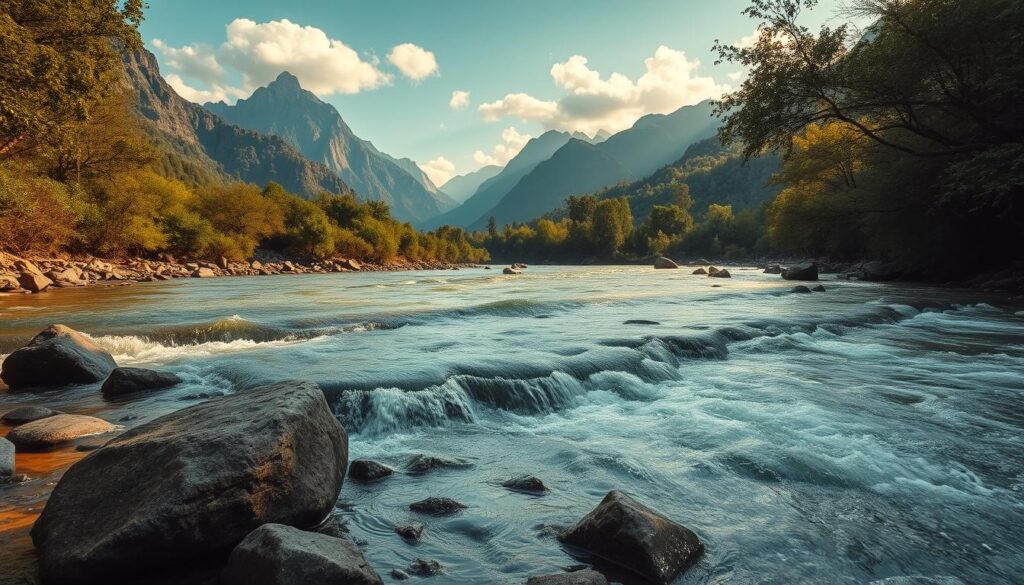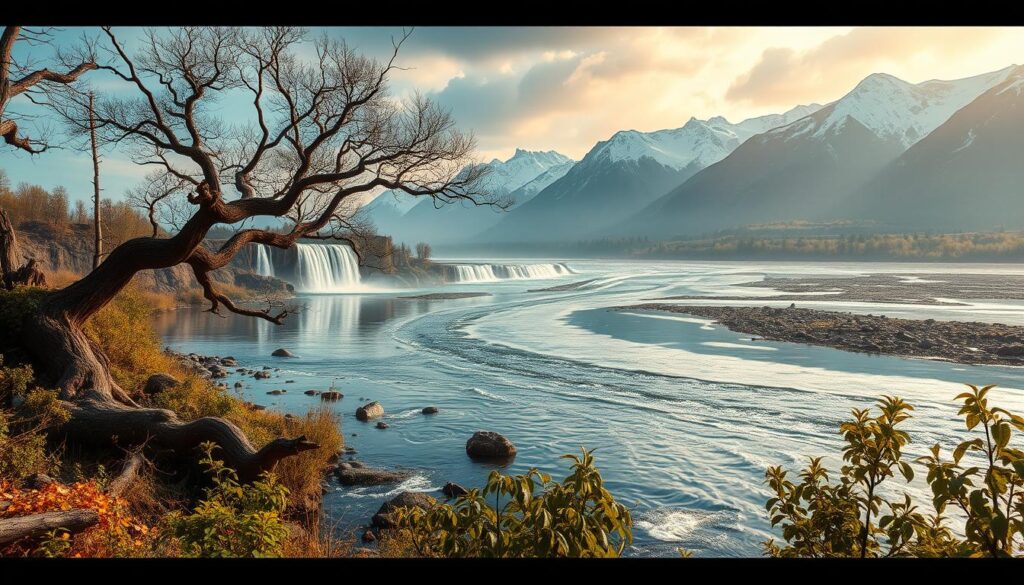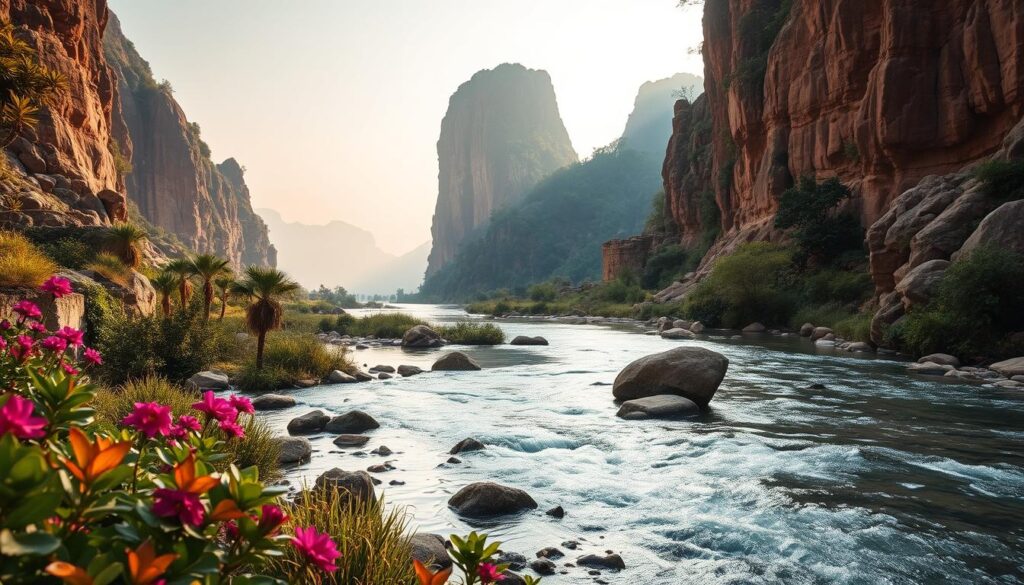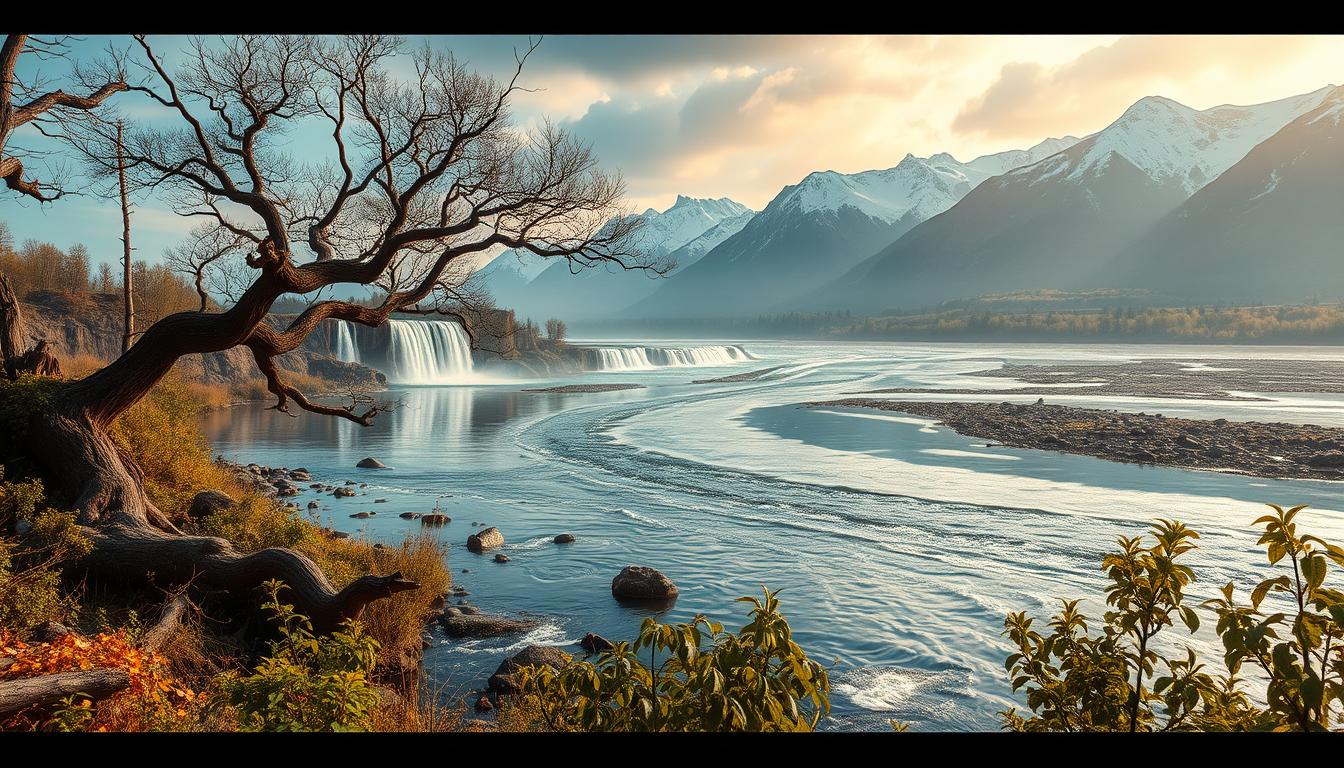Imagine a river that flows backward, defying physics and capturing the world’s imagination. This phenomenon may seem like science fiction. Yet, it has been observed and studied globally, showing the incredible power of time-reversed rivers. They are considered natural wonders and remarkable environmental phenomena.

These natural wonders fascinate many. Understanding them can give us valuable insights into environmental phenomena. In this article, we’ll explore the secrets of time-reversed rivers. We’ll look at the scientific explanations, ecological impact, and conservation efforts around these natural wonders.
Key Takeaways
- Time-reversed rivers are a rare and fascinating natural wonder found worldwide.
- These rivers are considered environmental phenomena that offer insights into science and nature.
- Understanding time-reversed rivers helps us appreciate the complexity and beauty of natural wonders.
- Time-reversed rivers have a significant impact on the environment and ecosystems around them.
- Conservation efforts are needed to protect these natural wonders and preserve them for future generations.
- Time-reversed rivers are an important area of study, with ongoing research helping us learn more about these remarkable environmental phenomena.
The Mysterious Phenomenon of a River Flows Backward in Time
To grasp this phenomenon, we must delve into temporal flow anomalies. These are irregularities in time’s flow. Natural forces, like changes in gravity or unique geological features, can reverse a river’s flow.
Scientific studies offer a deeper look into this phenomenon. Temporal flow anomalies can stem from Earth’s rotation changes, magnetic field shifts, or unknown celestial bodies.
Several factors contribute to a river’s flow reversal. These include:
- Natural forces, such as changes in gravitational fields or unusual geological formations
- Temporal flow anomalies, which refer to the irregularities in the flow of time
- Scientific observations and studies, which provide valuable insights into the underlying mechanisms that drive this phenomenon
By examining these factors, we can better understand the enigma of a river flowing backward in time.
The study of temporal flow anomalies and natural forces can provide valuable insights into the underlying mechanisms that drive this phenomenon, and can help us better understand the complex relationships between the Earth’s rotation, magnetic field, and gravitational fields.
Historical Documentation of Reverse-Flowing Rivers
Reverse-flowing rivers have long fascinated humans. They appear in ancient myths and modern science. These rivers have inspired many cultures, captured in texts, folklore, and stories passed down through generations.
In ancient times, rivers flowing backward were seen as magical. The Greeks thought they healed and held spiritual power. Native American legends also tell of such rivers, linking them to the world’s creation and nature’s balance.
Artists, writers, and musicians have been inspired by these rivers. They try to show their beauty and importance in their work. Looking into history, we learn more about these rivers’ cultural and spiritual value. We also gain insight into the natural world’s mysteries.
Some examples of reverse-flowing rivers include:
- The River Styx, which in ancient Greek mythology was believed to flow backward in time
- The River Ganges, which in Hindu mythology is believed to have healing properties and spiritual significance
- The Colorado River, which has been known to flow backward in certain areas due to unusual geological formations
By studying these rivers, we learn more about our world. We appreciate their cultural and spiritual importance. This helps us understand the natural world better.
The Science Behind Time-Reversed Water Flow
To understand time-reversed water flow, we must explore the science behind it. Quantum mechanics is key in how water acts at a molecular level, affecting river flow. Water’s unique traits, like high surface tension and viscosity, are shaped by gravitational influences and environmental factors.
The mix of these elements can create rivers that flow in reverse, seeming to break physics rules. Let’s look at the main factors:
- Quantum mechanics: influencing the behavior of water molecules
- Gravitational influences: shaping the flow of rivers and streams
- Environmental factors: geological formations, climate patterns, and more
By studying these factors, scientists can learn more about time-reversed water flow.
Exploring time-reversed rivers shows us how complex and interesting the science is. The blend of quantum mechanics, gravitational influences, and environmental factors gives us a peek into our planet’s waterways.
Geographic Locations of Time-Reversed Rivers
Time-reversed rivers exist in many geographic locations worldwide. They show the variety of our planet’s natural systems. You can find them in places like Alaska’s icy tundras and Australia’s hot deserts.
These rivers are often in areas with special geological features or unique environments. For example, Iceland’s waterfalls and the Amazon rainforest’s rivers are home to them. Exploring where these rivers are helps us appreciate our planet’s complexity.

These natural wonders come in different forms. You might see rivers flowing the wrong way, waterfalls that seem to go against gravity, or lakes that look frozen in time. Studying these rivers helps us understand where they are and why they happen.
Some key places to find time-reversed rivers include:
- Rivers in the Amazon rainforest
- Waterfalls in Iceland
- Lakes in the Australian outback
- Rivers in the Alaskan wilderness
These spots offer a unique look into nature. They also give scientists a chance to study and learn from thesetime-reversed rivers.
Impact on Local Ecosystems and Wildlife
The unique phenomenon of time-reversed rivers has a big ecological impact on the area around it. As the river moves in reverse, it forms a special ecosystem. This ecosystem supports many aquatic species.
These species have evolved to live in this unique environment. They have developed special traits and behaviors to survive.
Some of the main effects of time-reversed rivers on local ecosystems include:
- Changes in water temperature and chemistry, which can impact the distribution and abundance of aquatic species
- Alterations to the river’s sediment load, which can affect the formation of riverside habitats and the overall ecological impact of the river
- Shifts in the river’s nutrient cycle, which can have cascading effects on the entire ecosystem and environmental effects of the river
Understanding the environmental effects of time-reversed rivers is key for managing and conserving them. By studying the ecological impact of these rivers, we can learn about the complex relationships between the river, its inhabitants, and the environment. This knowledge helps us protect these unique ecosystems for the future.
Cultural Significance and Local Legends
Time-reversed rivers hold deep cultural value, filled with local legends and myths. They inspire and fascinate many, seen as sacred or mystical. These rivers’ stories are passed down through generations.
The local legends around these rivers talk of their healing powers. They say these rivers can change lives. Artists, writers, and musicians find inspiration in them. Festivals along their banks attract people worldwide.
Key aspects of these rivers’ cultural value include:
- Spiritual significance: Many see them as having spiritual powers and being sacred.
- Inspirational value: They inspire many in the arts and beyond.
- Educational value: They teach us about nature and conservation.

The cultural and legendary sides of time-reversed rivers show their deep impact. Exploring these, we appreciate our connection to nature more.
Modern Research and Scientific Discoveries
In recent years, we’ve made big strides in understanding time-reversed rivers. This is thanks to modern research and scientific discoveries in quantum mechanics and environmental science. These findings have helped us grasp the complex forces behind these rivers.
Some key areas of study include:
- Investigating the role of gravitational influences on river systems
- Examining the impact of environmental factors, such as climate change and human activity
- Developing new technologies to monitor and analyze time-reversed rivers
Looking ahead, future research directions will likely explore how to use time-reversed rivers. This could include harnessing their energy or learning from them for sustainable water management. By pushing forward, we can discover new things and care for our environment better.
Through ongoing studies and observations, we’re learning more about time-reversed rivers. This knowledge will help us in modern research and scientific discoveries. It will shape how we see the natural world.
Conservation Efforts and Environmental Protection
Keeping natural wonders like time-reversed rivers safe is a big task. We must support conservation efforts and environmental protection to keep our planet healthy.
Here are some ways to protect these special places:
- Using sustainable practices to lessen our impact
- Backing research and education to spread the word about conservation
- Working with local communities to make good conservation plans
Together, we can safeguard these natural wonders. This is key for our planet’s health and for environmental protection. With ongoing conservation efforts, we’ll keep time-reversed rivers beautiful for the next generations.
Conclusion: Understanding Nature’s Time-Bending Wonder
Exploring time-reversed rivers leaves us amazed by nature’s power. These wonders show us how nature can defy time and capture our hearts. They remind us of the universe’s complex beauty, encouraging us to learn more about science, philosophy, and culture.
Studying these rivers has opened a new door to understanding. It makes us think differently about time and how forces interact. By studying these phenomena, we’ve learned a lot about our planet’s balance and life’s ability to adapt.
As we move forward, protecting time-reversed rivers is key. We need to work together to study and care for them. This way, we can keep these wonders alive for future generations. They inspire us to appreciate the incredible beauty of our world.
FAQ
What is a time-reversed river?
A time-reversed river is a natural wonder where a river seems to flow backward. It goes against the usual laws of physics. This phenomenon fascinates people all over the world.
What causes a river to flow backward in time?
Several natural forces can make a river flow backward. These include changes in gravity or special geological shapes. These changes can cause the river to move in reverse.
Where can time-reversed rivers be found?
You can find time-reversed rivers in many places around the globe. They are often in areas with unique landscapes or special environments. For example, Iceland’s waterfalls and the Amazon rainforest’s rivers are famous for this.
How do time-reversed rivers impact local ecosystems and wildlife?
Time-reversed rivers can affect local ecosystems and wildlife in many ways. They might change how aquatic species adapt or alter habitats. These effects need careful study to understand their long-term impact.
What is the cultural significance of time-reversed rivers?
Time-reversed rivers hold deep cultural meaning. They are often tied to local legends and myths. Many cultures see them as sacred or mystical, inspiring people for centuries.
What are the latest scientific discoveries and research on time-reversed rivers?
Recent research has greatly improved our understanding of time-reversed rivers. Breakthroughs in quantum mechanics and environmental science have helped. Ongoing studies continue to reveal more about these natural wonders.
How can we conserve and protect time-reversed rivers and their ecosystems?
Protecting time-reversed rivers and their ecosystems is crucial. We need to support conservation efforts and environmental protection. This will help preserve these wonders for future generations.
